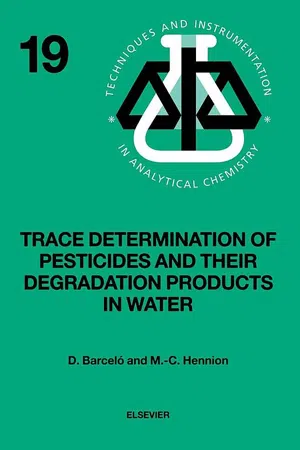
Trace Determination of Pesticides and their Degradation Products in Water (BOOK REPRINT)
- 556 pages
- English
- ePUB (mobile friendly)
- Available on iOS & Android
Trace Determination of Pesticides and their Degradation Products in Water (BOOK REPRINT)
About this book
Trace Determination of Pesticides and their Degradation Products in Water is a critical compilation of analytical methods for the monitoring of pesticides and their degradation products in water. It contains up-to-date material and is the result of the authors' experience in the pesticide analysis field. The book is structured in six chapters, starting from general aspects of pesticides like usage, physicochemical parameters and occurrence in the environment. A second chapter is devoted to sampling from water matrices, stability methods of pesticides in water and quality assurance issues. The general chromatographic methods for pesticides are reported, including the newly developed electrophoresis methods and GC-MS and LC-MS confirmatory analytical methods. Sample preparation methodologies, including off-line and on-line techniques are described in the next two chapters, with a comprehensive list of examples of pesticides and many metabolites, including the use of different GC-methods and LC-methods. The final chapter is devoted to the development of biological techniques, immunoassays and biosensors, for the trace determination of pesticides in water samples.
Frequently asked questions
- Essential is ideal for learners and professionals who enjoy exploring a wide range of subjects. Access the Essential Library with 800,000+ trusted titles and best-sellers across business, personal growth, and the humanities. Includes unlimited reading time and Standard Read Aloud voice.
- Complete: Perfect for advanced learners and researchers needing full, unrestricted access. Unlock 1.4M+ books across hundreds of subjects, including academic and specialized titles. The Complete Plan also includes advanced features like Premium Read Aloud and Research Assistant.
Please note we cannot support devices running on iOS 13 and Android 7 or earlier. Learn more about using the app.
Information
Pesticides their Degradation Products:Characteristics Usage Environmental Behaviour
1.1 INTRODUCTION
1.1.1 Historical context of pesticide use
Table of contents
- Cover image
- Title page
- Table of Contents
- Copyright
- Preface
- Chapter 1: Pesticides their Degradation Products:Characteristics Usage Environmental Behaviour
- Chapter 2: Quality Assurance Issues: Sampling, Storage and Interlaboratory Studies
- Chapter 3: Chromatographic and Related Techniques for the Analysis and Detection of Pesticides
- Chapter 4: Sample Handling Techniques (Extraction and Clean-up of Samples)
- Chapter 5: On-Line Sample Handling Strategies
- Chapter 6: Immunochemical Methods and Biosensors
- Subject Index